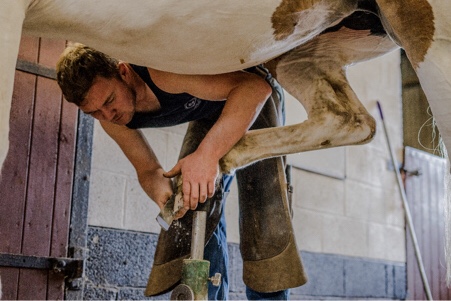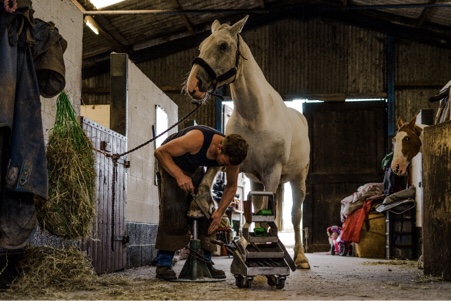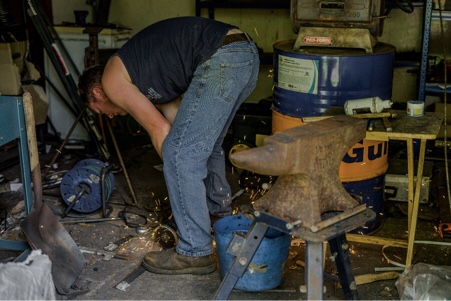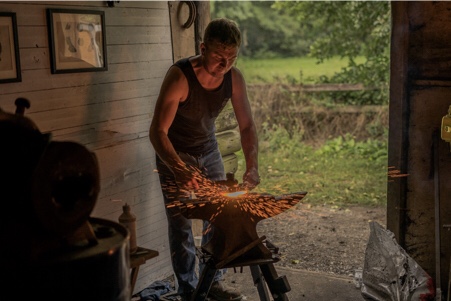
“Strike while the iron’s hot” my nephew and Master Farrier, Marc Jerram, informed me during my visit to photograph him at work, refers to the importance of working metal while it is at its hottest, as when it cools it is much harder to hammer into shape. Words of wisdom that have stayed with me since my visit.
Not normally a morning person I forced myself to rise early, arriving at his yard at just after 7 am (a time of day I had forgotten even existed). The effort was worth it, however, for in the stillness of the morning I found Marc already at work shoeing his horse. Saturday morning is Marc’s time for shoeing his own horses and for any specialised work he doesn’t have time for in the week. This Saturday was no exception.
It was great to see Marc’s cheery face, smiling from underneath his horse, as he worked on one of its shoes.

Marc seemed to make light work at what is obviously a tough job, making the complex process of shoeing a horse look simple, as I quickly took pictures of the various tasks involved. These included:
Cleaning the hooves of loose flakes:

Rasping:

Shaping the shoe:



Checking for uneven areas on the hoof with a heated shoe:


Nailing:

Twisting off and bending the protruding nails with clinching tongues:

Final rasping:

Resulting in four perfectly shod shoes:

After shoeing another horse we moved over to the forge, where Marc started work on a specialised shoe for a lame horse. Marc first cut a piece of steel to length based on measurements from the horse’s shoe.

Marc then heated the steel, bringing it up to a workable temperature, in a traditional coke forge.

Before starting the shaping process:

Constantly working it and reheating it to keep it at temperature:

While checking for size against the original shoe:

Intermittently brushing and cleaning the surface to remove any impurities:

And further shaping:

Then applying flux to increase temperature for fire welding, the oldest form of welding, when heated in the forge:

Before hammering the ends together and making the weld:

And applying the final touches:

Creating the perfect weld!

Marc then punches holes:


Followed by rasping and finishing off:

And creating marker holes:

Leaving the finished product ready for stage two of the shoe:

For this stage of the shoe Marc cuts out an aluminium plate to roughly the correct size.

And drills holes into the shoe, threading them ready for the plate to bolt onto.

Then he marks out the matching holes for the aluminium plate.

Which he then drills.

And then trims the bolts down to size.

Which he then uses to bolt the two plates together.
And then finishing off by refining and shaping the plate.
Leaving the completed shoe.


This shoe was then used to treat the horse, with the dressing for the affected hoof held in place between the horseshoe and plate. This also means that it can easily be changed.
The last four photos of the before and during treatment supplied by Marc:
Before:

After surgery:

With the shoe fitted:

During recovery:

This is a real demonstration of the skill of Marc, a farrier at the top of his game, who’s craft is so valued by all his customers he shoes horses for. The horse was suffering from canker, which is a rare infection of the frog of the hoof. It is still too soon to know if the horse is fully recovered, but I do know Marc has given it the best chance possible and I hope it’s recovery continues progress well.
For more images from the day and to see more of my photographs, visit my website:
